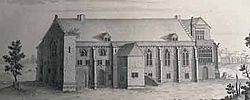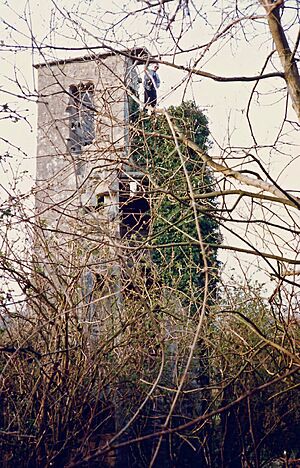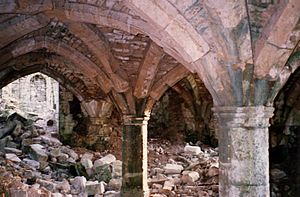Bradenstoke Priory facts for kids

18th-century engraving of the Priory by Samuel and Nathaniel Buck
|
|
| Monastery information | |
|---|---|
| Order | Augustinian |
| Established | 1142 |
| Disestablished | 1539 |
| Dedicated to | St. Mary |
| People | |
| Founder(s) | Walter FitzEdward de Salisbury |
| Site | |
| Location | Bradenstoke, Wiltshire, England |
| Coordinates | 51°30′44″N 2°00′13″W / 51.51222°N 2.00361°W |
| Visible remains | Tower and undercroft |
| Public access | No |
Bradenstoke Priory was an old monastery in England, built during the Middle Ages. It was home to Augustinian canons, who were a type of religious group. The priory was located on a high ridge in Wiltshire, about 2.4 kilometers (1.5 miles) west of Lyneham.
In the 1930s, an American businessman named William Randolph Hearst bought parts of the priory. He used some of its old structures to help rebuild St Donat's Castle in Wales.
Contents
How Bradenstoke Priory Started and Grew
The priory began in 1142 and was first called the Priory of Clack. It was dedicated to Saint Mary. The location was chosen well, on a high ridge near a holy well and other springs. There might have even been a small chapel there before the priory was built.
The founder was Walter FitzEdward de Salisbury. He was the son of a very important local official, Edward de Salisbury. Walter gave land for the priory to be a "daughter house" of Cirencester Abbey. This meant it was connected to the abbey and was meant "to serve God forever!"
After his wife passed away, Walter himself joined the canons at the priory. When he died in 1147, he was buried there. His family, the Earls of Salisbury, stayed closely involved with the priory for many years. Later, in 1190, thirteen canons from Bradenstoke left to start a new community at Cartmel Priory in Cumbria.
The priory also received support from the kings of England. King Henry II gave them a special charter between 1173 and 1179. King Richard I helped the priory become independent from Cirencester Abbey. King John, who visited often, confirmed this independence. This royal support continued with King Henry III, who visited in 1235.
By the 1300s, Bradenstoke Priory had become very wealthy. It owned land in nine different counties, not just Wiltshire. This wealth did not mean the canons lived in luxury or were corrupt. The priory was also quite important. One of its leaders, Prior Thomas Wallashe, even lived with Cardinal Bainbridge in Rome for several years. This led to the priory receiving special permissions from the Pope.
The Priory Closes Down
At first, it seemed Bradenstoke Priory might avoid the Dissolution of the Monasteries. This was when King Henry VIII closed down many religious houses in England. The last prior, William Snowe, even wrote to Thomas Cromwell, a powerful advisor to the King, thanking him for saving the monastery.
However, the priory was eventually closed. Prior Snowe and thirteen canons gave up the priory on January 17, 1539. Around this time, the priory's total income was about £270. After it closed, the land and buildings were given to a man named Richard Pexel. His family later sold it to the Methuen family.
Prior Snowe was given a pension by the King. He later became the Dean of Bristol, an important church leader.
John Aubrey, a writer from the 1600s, described the priory as "Very well built, with good strong ribs." He said its cellar was "the stateliest in Wiltshire." But he also noted that by 1666, even the foundations of the church were being dug up. He saw old stone coffins and parts of Gothic pillars. He mentioned that the King's lodgings, which were said to be very grand, were still standing around 1588.
What Happened Recently
In 1925, William Randolph Hearst, a rich American newspaper owner, saw St Donat's Castle for sale. He bought it and also purchased parts of Bradenstoke Priory. He took the guest house, the Prior's lodging, and the great tithe barn from Bradenstoke. Some of these materials were used to create a grand banqueting hall at St Donat's Castle. This hall included a 16th-century French fireplace and windows. A 14th-century roof was also used for the Bradenstoke Hall at the castle.
The demolition of the priory was strongly opposed by groups like the Society for the Protection of Ancient Buildings. They even put up posters on the London Underground to protest. The tithe barn was packed into crates and sent to Hearst Castle in California. It was later sold again when Hearst lost interest. The crates with the barn's roof timbers are still stored in a warehouse in California.
What Remains Today
Today, all that is left of Bradenstoke Priory are its tower and its undercroft. An undercroft is a vaulted room, usually underground. In 1996–97, English Heritage identified the undercroft as being at risk and needing urgent repairs. In 2005, it was announced that money would be provided to help preserve the orchard and land around the ruins.
The undercroft was placed on the Heritage at Risk Register by Historic England. This allowed for grants in 2017 and 2019 to help the owner. The money was used for initial support, waterproofing, and investigations. Then, a major project repaired and made the ruins stable. This work was finished in January 2020.
Images for kids





